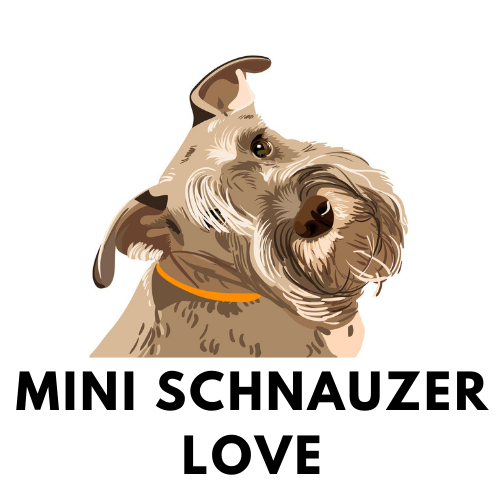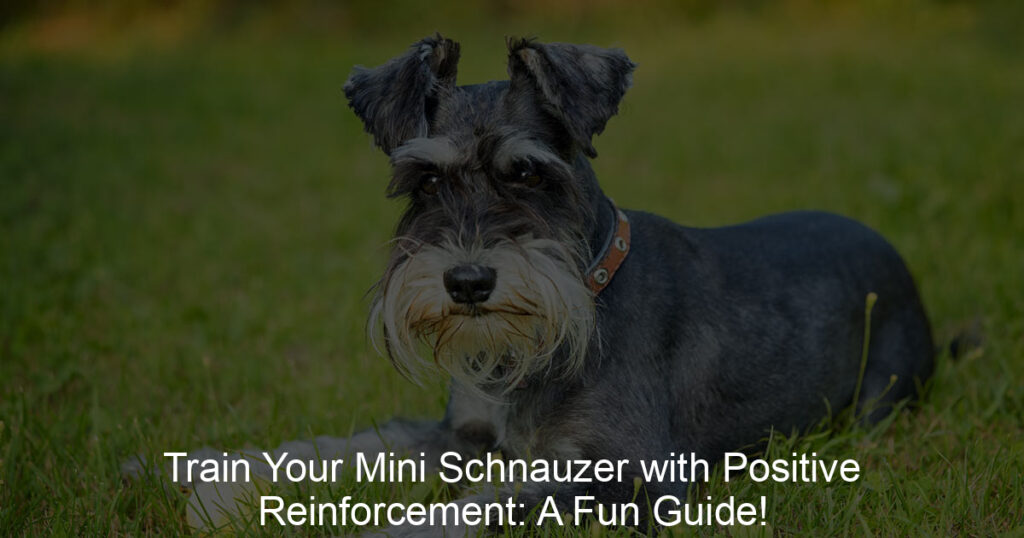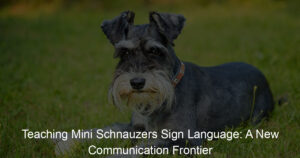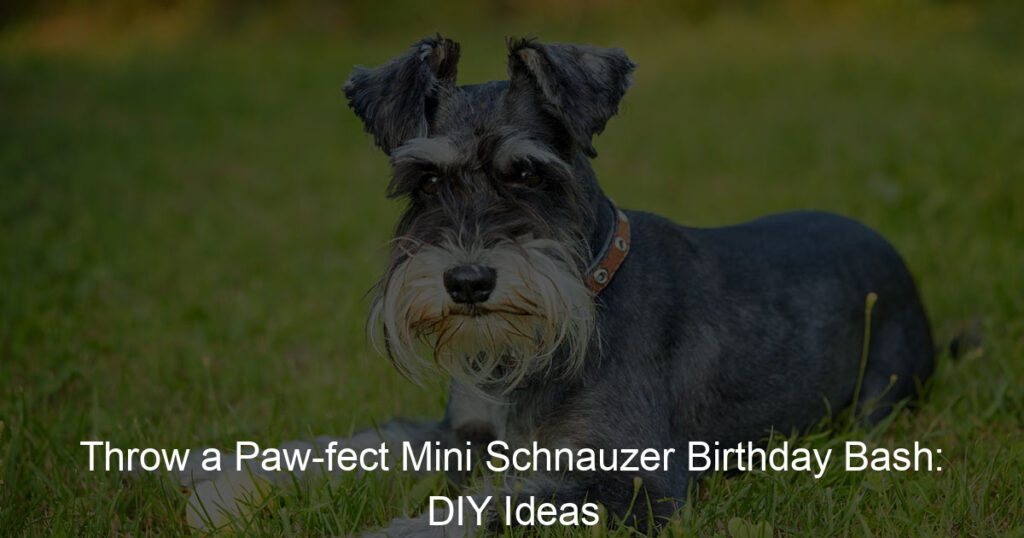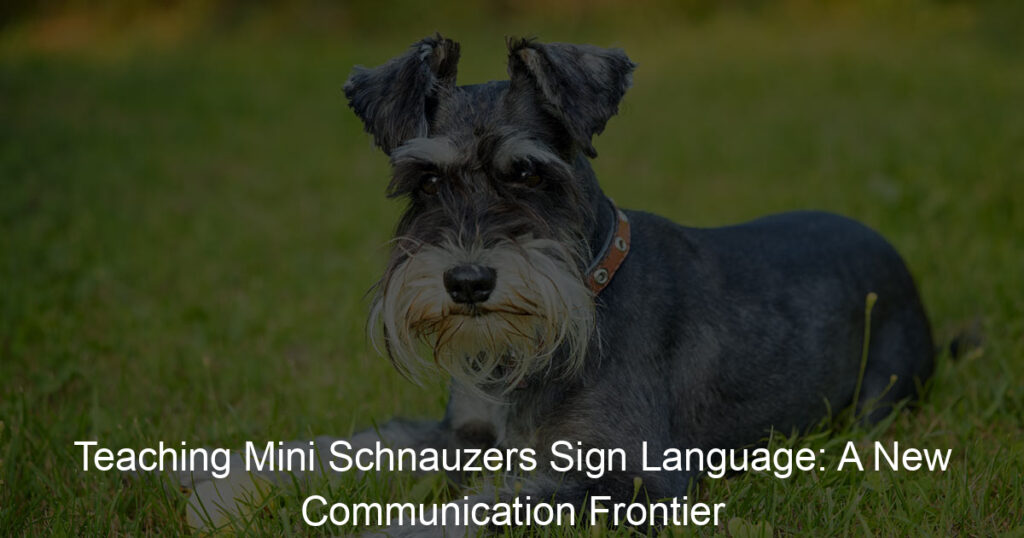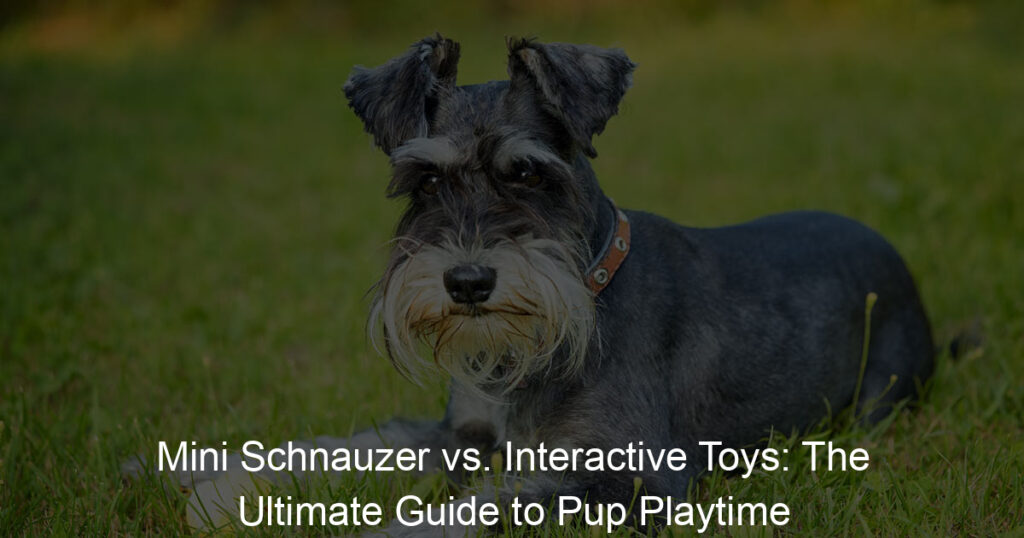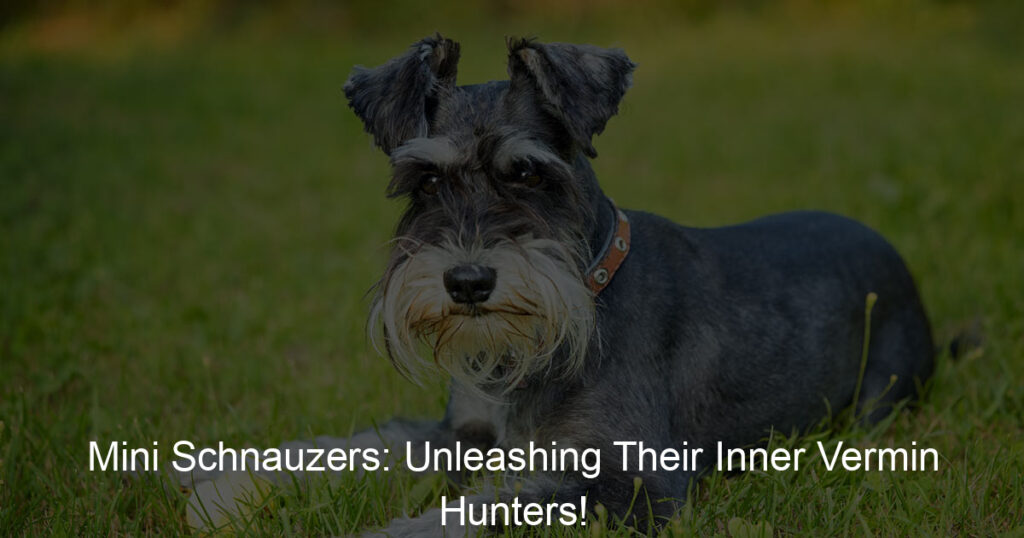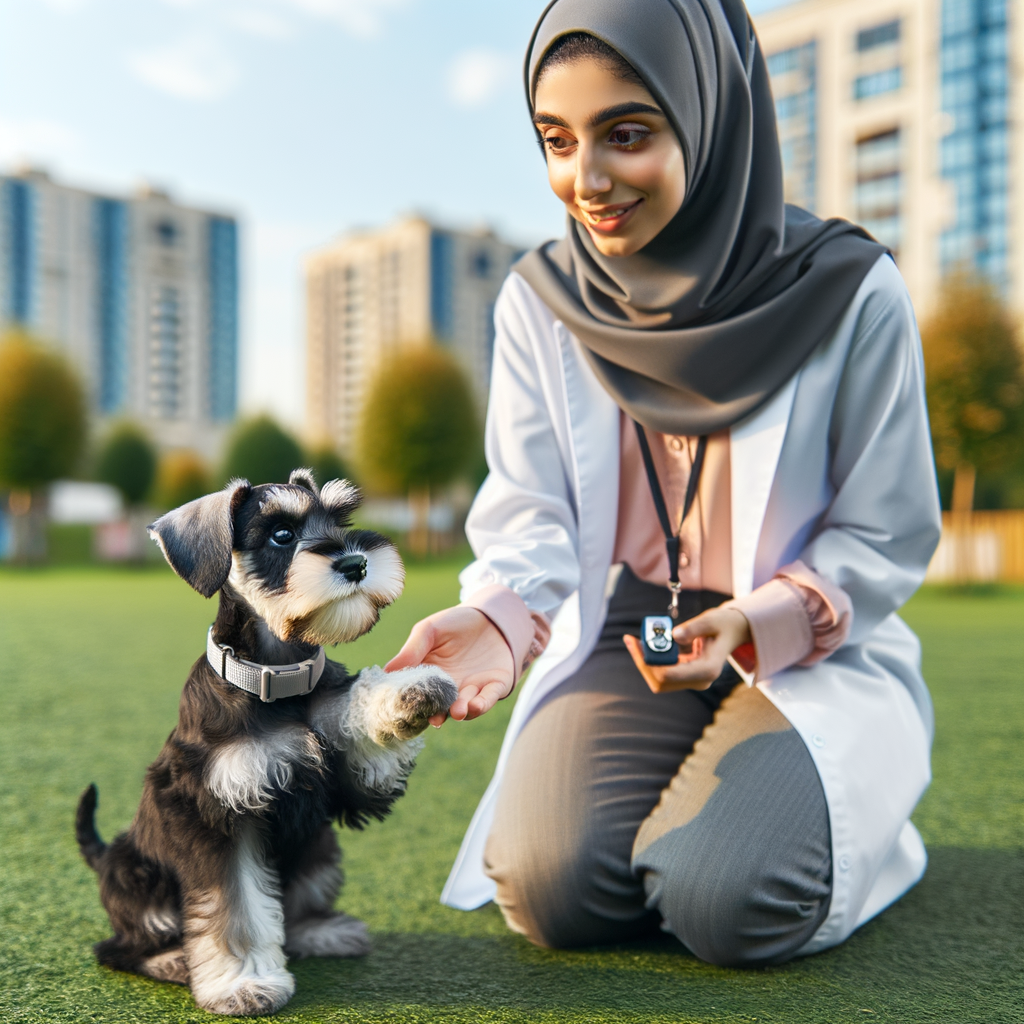
Introduction to Mini Schnauzer Training
Training your Mini Schnauzer is not just about teaching them tricks or obedience. It’s about building a strong bond and understanding between you and your furry friend. In this section, we will delve into the importance of training your Mini Schnauzer and provide an overview of positive reinforcement for dogs.
- Understanding the Importance of Training Your Mini Schnauzer
- Overview of Positive Reinforcement for Dogs
Training your Mini Schnauzer is crucial for several reasons. Firstly, it helps to establish a healthy relationship between you and your pet. Training sessions are a great way to spend quality time together and strengthen your bond. Secondly, it helps to instill good manners in your dog. A well-trained Mini Schnauzer is less likely to engage in destructive behaviors such as chewing on furniture or digging in the garden. Lastly, training can be a lifesaver. Teaching your dog basic commands like “sit”, “stay”, and “come” can prevent accidents and keep your pet safe.
Positive reinforcement is a method of training that rewards good behavior. Instead of punishing your dog for doing something wrong, you reward them for doing something right. This could be with a treat, a toy, or simply a pat on the head. The idea is to make good behavior more appealing to your dog than bad behavior. Studies have shown that dogs trained using positive reinforcement are less likely to exhibit problem behaviors and are generally happier and more confident. It’s a win-win situation for both you and your Mini Schnauzer!
Training your Mini Schnauzer can be a rewarding experience. It requires patience, consistency, and a lot of love. But the end result is a well-behaved, happy, and confident dog that is a joy to be around. So, let’s dive into the world of Mini Schnauzer training!
Basics of Positive Reinforcement for Dogs
Training your dog can be a rewarding experience, especially when you use the right techniques. One of the most effective methods is positive reinforcement. But what exactly is positive reinforcement, and how can it benefit your dog training efforts?
What is Positive Reinforcement?
Positive reinforcement is a method used in dog training that focuses on rewarding good behavior. Instead of punishing your dog for bad behavior, you reward them when they do something right. This encourages them to repeat the good behavior in the future.
- Definition and explanation of positive reinforcement techniques for dogs: Positive reinforcement involves giving your dog a reward to encourage the behavior you want. The reward could be a treat, a toy, or praise. For example, if your dog sits when you tell them to, you might give them a treat as a reward. This makes it more likely that they will sit when asked in the future.
- Benefits of using positive reinforcement in dog training: Positive reinforcement has many benefits. It can help build a stronger bond between you and your dog. It can also make training more enjoyable for your dog and increase their eagerness to learn. Studies have shown that dogs trained using positive reinforcement are more likely to retain what they’ve learned.
Positive reinforcement is not just about giving treats. It’s about creating a positive association with good behaviors. When your dog understands that good things happen when they do what you ask, they’re more likely to do it again. This is the power of positive reinforcement in dog training.
Implementing Positive Reinforcement in Training
Positive reinforcement is a powerful tool in dog training. It encourages good behavior by rewarding the dog when it does something right. Let’s explore how to implement this technique in training, with a focus on Mini Schnauzers.
- Step-by-step guide to using positive reinforcement in training
- Identify the behavior: Decide what behavior you want to encourage in your dog. It could be anything from sitting on command to not jumping on guests.
- Choose a reward: Find something your dog loves. This could be a favorite treat, a toy, or even praise and petting.
- Catch the behavior: Watch for your dog to perform the desired behavior. When it does, immediately give the reward.
- Repeat: Consistency is key in training. Repeat the process regularly so your dog associates the behavior with the reward.
- Examples of positive reinforcement techniques for dogs
- Treats: Most dogs love treats, making them a great reward. Just be sure not to overdo it and maintain a balanced diet.
- Praise: Dogs crave attention and approval. A simple “good dog” or a pat on the head can go a long way.
- Playtime: If your Mini Schnauzer loves to play, use its favorite game as a reward. This can be especially effective for teaching commands like “fetch” or “sit”.
Training your Mini Schnauzer using positive reinforcement involves a few key steps:
Remember, patience is crucial. Training takes time, but with positive reinforcement, it can be a fun and rewarding experience for both you and your Mini Schnauzer.
There are many ways to use positive reinforcement in training. Here are a few examples:
These are just a few examples. The best reward is something your Mini Schnauzer loves and motivates it to repeat the behavior.
In conclusion, positive reinforcement is a powerful training tool. It encourages good behavior in a positive, loving way. With patience and consistency, you can use this technique to train your Mini Schnauzer effectively.
Teaching Basic Commands to Dogs
Training your dog to understand and follow basic commands is a crucial part of responsible pet ownership. It can be particularly rewarding when you’re working with a Mini Schnauzer, a breed known for its intelligence and eagerness to please. Let’s explore some essential commands for this breed and how to teach them using positive reinforcement.
Essential Commands for Mini Schnauzer
Mini Schnauzers, like all dogs, benefit from learning a set of basic commands. These commands not only help you communicate with your dog but also ensure their safety and well-being. Here’s an overview of the commands that every Mini Schnauzer should know:
- Sit: This command is fundamental and often the first one taught. It’s useful in various situations, such as when you need your dog to calm down or stay in one place.
- Stay: This command is vital for keeping your dog safe. It can prevent them from running into the street or approaching a potentially dangerous situation.
- Come: This command is crucial for recall, especially in outdoor environments. It can help you quickly get your dog’s attention and bring them back to you.
- Leave it: This command helps prevent your dog from picking up or eating something they shouldn’t. It’s particularly useful for Mini Schnauzers, who are known for their curiosity.
Now that we’ve covered the basic commands, let’s discuss how to teach them using positive reinforcement.
How to Teach Each Command Using Positive Reinforcement
Positive reinforcement involves rewarding your dog for performing a desired behavior. This method is highly effective and promotes a strong bond between you and your pet. Here’s a step-by-step guide on how to use positive reinforcement to teach each command:
- Choose a reward: This could be a favorite treat, toy, or praise. The key is to choose something that your dog loves and will work for.
- Give the command: Say the command clearly and firmly. Make sure to use the same word and tone each time so your dog can easily recognize it.
- Wait for the behavior: Give your dog a few seconds to understand and perform the command. If they don’t respond, try again after a short break.
- Reward the behavior: As soon as your dog performs the desired behavior, reward them immediately. This helps them associate the behavior with the reward.
- Repeat: Practice the command regularly. Consistency is key to helping your dog understand and remember the command.
Remember, patience and consistency are key in dog training. It may take time, but with positive reinforcement, your Mini Schnauzer will soon be following your commands with ease.
Common Challenges and Solutions
Training your Mini Schnauzer to follow basic commands can sometimes be a challenging task. However, understanding these challenges and knowing how to overcome them can make the process smoother and more enjoyable for both you and your furry friend.
- Identifying Common Issues in Teaching Basic Commands to Dogs
- Practical Solutions and Tips to Overcome These Challenges
- Be consistent: Use the same commands and gestures each time. This will help your dog understand what you’re asking of them.
- Use positive reinforcement: Reward your dog when they follow a command correctly. This could be a treat, a toy, or simply a pat on the head. This will encourage them to repeat the behavior in the future.
- Be patient: Remember, learning takes time. Don’t rush your dog, and always end training sessions on a positive note.
One of the most common issues that dog owners face when teaching basic commands is a lack of consistency. This can lead to confusion for your Mini Schnauzer, making it harder for them to understand what you’re asking of them. Another common issue is not using positive reinforcement correctly, which can hinder your dog’s learning process.
Overcoming these challenges may seem daunting, but with a few practical solutions and tips, you can effectively teach your Mini Schnauzer basic commands. Here are a few tips:
Training your Mini Schnauzer can be a rewarding experience. By understanding common challenges and implementing these practical solutions, you’ll be well on your way to having a well-trained and happy dog.
Mini Schnauzer Obedience Training
Obedience training is a crucial part of raising a Mini Schnauzer. It helps establish a healthy relationship between you and your furry friend, ensuring a harmonious living environment. Let’s delve into the importance of obedience training and how it benefits your Mini Schnauzer.
Importance of Obedience Training
Obedience training plays a significant role in shaping the behavior of a Mini Schnauzer. It’s not just about teaching your dog to follow commands, but it’s also about instilling good manners and promoting a better understanding between you and your pet.
- Understanding the role of obedience training in a Mini Schnauzer’s behavior
- Benefits of Mini Schnauzer obedience training
Obedience training is a fundamental aspect of a Mini Schnauzer’s behavior. It helps them understand what is expected of them, making them more confident and less anxious. Training also provides mental stimulation, which Mini Schnauzers need to prevent boredom and destructive behaviors.
There are numerous benefits to obedience training your Mini Schnauzer. It strengthens the bond between you and your pet, enhances safety, and improves your dog’s social skills. Trained dogs are generally happier, more relaxed, and easier to manage. Plus, it’s a great way to keep your Mini Schnauzer’s mind sharp!
In conclusion, obedience training is essential for every Mini Schnauzer. It not only improves their behavior but also enhances their overall quality of life. So, invest time in training your Mini Schnauzer and reap the benefits of having a well-behaved, happy, and healthy pet.
Obedience Training Techniques
Training your Mini Schnauzer to obey commands is a crucial part of their overall behavior. This section will provide a step-by-step guide to obedience training using positive reinforcement and share some successful case studies of Mini Schnauzer obedience training.
- Step-by-step guide to obedience training using positive reinforcement
- Step 1: Choose a command and stick with it. Consistency is key in dog training.
- Step 2: When your Mini Schnauzer performs the desired behavior, immediately reward them with a treat or praise.
- Step 3: Repeat the process. Repetition is crucial in reinforcing the behavior.
- Step 4: Gradually increase the time between the command and the reward. This will help your dog understand that they need to perform the command before they receive the reward.
- Step 5: Practice in different environments. This will help your dog generalize the command, understanding that it applies in all situations, not just at home.
- Case studies of successful Mini Schnauzer obedience training
Positive reinforcement is a method where you reward your dog for the behavior you want, encouraging them to repeat it. Here’s how you can use it for obedience training:
Many Mini Schnauzer owners have found success with obedience training. Here are a couple of examples:
| Owner | Training Technique | Result |
|---|---|---|
| John | Used positive reinforcement with treats | His Mini Schnauzer learned to sit on command within two weeks |
| Sarah | Used positive reinforcement with praise | Her Mini Schnauzer learned to stay on command within a month |
These case studies show that with patience and consistency, positive reinforcement can be a highly effective method for obedience training.
Training Mini Schnauzer Puppies
Training your Mini Schnauzer puppy can be a rewarding experience for both you and your furry friend. With the right approach, you can help your puppy grow into a well-behaved and obedient adult dog.
Starting Early: Puppy Training
Starting your Mini Schnauzer’s training early is crucial for several reasons. Let’s explore why it’s so important and how you can effectively train your puppy using positive reinforcement.
- Importance of starting training early with Mini Schnauzer puppies
- How to train a Mini Schnauzer puppy using positive reinforcement
- Identify a reward your puppy loves: This could be a favorite treat, a toy, or even praise and petting.
- Give the reward immediately after good behavior: This helps your puppy understand what they did right.
- Be consistent: Consistency is key in training. Always reward your puppy for good behavior, and avoid rewarding bad behavior.
Training should start as soon as your Mini Schnauzer puppy arrives home. This is typically around 8 weeks old. Starting early helps your puppy understand the rules of the house, and it’s also the time when they are most receptive to learning new things. Early training can help prevent behavioral issues later on, making your life and your puppy’s life much easier.
Positive reinforcement is a powerful training method. It involves rewarding your puppy for good behavior, which encourages them to repeat it. To use positive reinforcement with your Mini Schnauzer puppy, you’ll need to:
Remember, patience is key when training your Mini Schnauzer puppy. With time and consistency, your puppy will learn to behave well and respond to your commands.
Puppy Training Challenges and Solutions
Training a Mini Schnauzer puppy can be a rewarding experience, but it’s not without its challenges. Let’s explore some of the common issues faced by new puppy owners and practical solutions to overcome them.
- Common challenges in training Mini Schnauzer puppies
- Stubbornness: Mini Schnauzers can be quite stubborn. They may resist commands or try to assert their dominance.
- Distraction: These puppies are naturally curious and can easily get distracted during training sessions.
- Barking: Mini Schnauzers are known for their vocal nature. Excessive barking can be a challenge during training.
- Socialization: Some Mini Schnauzers may be wary of strangers or other dogs, making socialization a challenge.
- Practical solutions and tips to overcome these challenges
- Positive Reinforcement: Reward your puppy for good behavior. This could be in the form of treats, praise, or playtime.
- Consistent Training: Keep training sessions short but regular. Consistency is key in dog training.
- Distraction Training: Train your puppy in a quiet, distraction-free environment initially. Gradually introduce distractions as they get better at focusing.
- Socialization: Expose your puppy to different people, environments, and other dogs early on to help them become well-adjusted adults.
Mini Schnauzers are intelligent and energetic dogs, but their spirited nature can sometimes make training a bit tricky. Here are some common challenges:
Despite these challenges, with patience and consistency, you can successfully train your Mini Schnauzer puppy. Here are some practical tips:
Remember, every puppy is unique and what works for one might not work for another. It’s about finding what motivates your Mini Schnauzer and using that to guide your training approach. With time, patience, and love, you’ll be able to overcome these challenges and enjoy a well-behaved and happy Mini Schnauzer.
Mini Schnauzer Behavior Training
Training your Mini Schnauzer is not just about teaching them tricks or obedience commands. It also involves understanding their behavior and knowing how to influence it positively. In this section, we will explore Mini Schnauzer behavior and how training can help improve it.
Understanding Mini Schnauzer Behavior
Before we delve into the training aspect, it’s crucial to understand the typical behaviors of a Mini Schnauzer. This understanding will help you tailor your training methods to suit your pet’s unique needs.
- Overview of typical Mini Schnauzer behaviors: Mini Schnauzers are known for their lively and spirited nature. They are intelligent, alert, and often have a strong-willed streak. They love to play and are usually friendly towards people and other animals. However, without proper training, they can develop undesirable behaviors such as excessive barking, digging, or chewing.
- How training can influence and improve behavior: Training can help channel your Mini Schnauzer’s energy into positive behaviors. It can help reduce unwanted behaviors by providing mental stimulation and establishing clear boundaries. For instance, teaching your Mini Schnauzer to sit or stay on command can discourage them from jumping on guests. Similarly, regular play and exercise can help curb excessive barking or chewing by keeping them occupied and satisfied.
Understanding your Mini Schnauzer’s behavior is the first step towards effective training. Remember, every dog is unique and what works for one might not work for another. Therefore, patience and consistency are key in this process.
Behavior Training Techniques
Training your Mini Schnauzer can be a rewarding experience. By using the right techniques, you can shape their behavior in a positive way. Let’s explore some of these methods.
- Step-by-step guide to behavior training using positive reinforcement
- Case studies of successful Mini Schnauzer behavior training
Positive reinforcement is a powerful tool in behavior training. It involves rewarding your dog for good behavior, encouraging them to repeat it. Here’s a simple guide to get you started:
| Step | Action |
|---|---|
| 1 | Identify the behavior you want to encourage. For example, sitting on command. |
| 2 | Choose a reward. This could be a treat, praise, or a favorite toy. |
| 3 | Wait for your dog to perform the behavior, then immediately reward them. |
| 4 | Repeat this process regularly. Consistency is key in training. |
| 5 | Gradually reduce the frequency of rewards as your dog learns the behavior. |
Many Mini Schnauzer owners have found success with behavior training. Let’s look at a couple of examples:
Case Study 1: Bella
Bella was a Mini Schnauzer who loved to jump on visitors. Her owner used positive reinforcement to train her to sit instead. Every time Bella sat when a visitor arrived, she received a treat. Over time, Bella learned to sit instead of jumping up.
Case Study 2: Max
Max was a Mini Schnauzer with a barking problem. His owner used a combination of positive reinforcement and distraction techniques. Whenever Max started to bark, his owner would distract him with a toy. When Max stopped barking and focused on the toy, he received praise and a treat. This helped Max learn to control his barking.
These techniques can help you train your Mini Schnauzer effectively. Remember, patience and consistency are key. Happy training!
Conclusion: The Joy of Training Your Mini Schnauzer
As we reach the end of our journey, it’s time to reflect on the importance and joy of training your beloved Mini Schnauzer. Training is not just about teaching commands; it’s about building a strong bond with your furry friend and ensuring their health and happiness.
- Recap of the importance and benefits of training your Mini Schnauzer
- Encouragement for continued training and reinforcement
Training your Mini Schnauzer is crucial for both their physical and mental well-being. It helps in keeping them disciplined and well-behaved, making them a joy to be around. Training also reduces the risk of behavioral problems, making your life and your pet’s life more comfortable and enjoyable.
Moreover, training is a fantastic way to strengthen the bond between you and your Mini Schnauzer. It’s a time for interaction, communication, and mutual understanding. It’s a time where you can understand your pet better and vice versa.
Statistics show that trained dogs are happier and healthier. They are less likely to develop behavioral problems and are more likely to live longer, healthier lives. So, training your Mini Schnauzer is not just beneficial for you but also for your beloved pet.
Training is not a one-time task. It’s a continuous process that requires patience, consistency, and love. It’s important to keep reinforcing the training and commands regularly to ensure they stick.
Remember, every dog learns at their own pace. So, don’t be disheartened if your Mini Schnauzer takes a little longer to learn a command or behavior. Keep encouraging them, keep rewarding them, and most importantly, keep loving them.
Training your Mini Schnauzer can be a joyful and rewarding experience. It’s a journey filled with love, patience, and mutual understanding. So, keep training, keep learning, and keep enjoying the beautiful bond you share with your Mini Schnauzer.
In conclusion, training your Mini Schnauzer is not just about teaching commands; it’s about building a bond, understanding each other, and ensuring a happy and healthy life for your pet. So, embrace the joy of training and embark on this beautiful journey with your Mini Schnauzer.
